
- Home
- Travel Packages
- Top Destination
-
Travel Attraction
By Category
Top Attraction

- Travel Agents
- Car Rentals
- Hotels
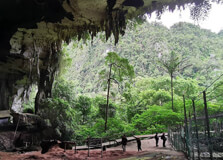
Niah National Park is located in Sarawak, Malaysia, approximately 110 km southwest of Miri. It covers an area of 3,140 hectares and is known for its vast limestone cave system, rich biodiversity, and archaeological significance. The park is home to a variety of plant and animal species, as well as ancient cave paintings and archaeological sites that provide insights into the region's history. Location and Geographical Overview The park is situated in the district of Miri, Sarawak, in the northeastern part of the island of Borneo. It is surrounded by lush tropical rainforest and limestone hills, creating a diverse and unique habitat for flora and fauna. Open and Closing Time The Niah National Park is open daily from 8:00 am to 5:00 pm. Entry Fee The entry fee for adults is RM10, while children under 18 years old can enter for free. Malaysian senior citizens aged 60 and above can also enter for free. Species-Flora/Fauna Availability The park is home to a wide variety of plant and animal species, including rare orchids, pitcher plants, hornbills, monkeys, and bats. Visitors can explore the diverse flora and fauna through guided tours and jungle treks. Activities Performed Visitors to Niah National Park can engage in activities such as cave exploration, bird watching, jungle trekking, and visiting the archaeological sites. Guided tours are available for those who wish to learn more about the park's history and wildlife. Jeep Safari Charges Jeep safari tours are available at an additional cost, with prices starting from RM50 per person. The safari allows visitors to explore the park's remote areas and spot wildlife from the comfort of a vehicle. Age Criterion for Male, Female, Children, and their Entry Fee Adult entry fees apply to individuals aged 18 and above. Children under 18 can enter for free, while senior citizens aged 60 and above can also enter for free with proof of age. Senior Citizen Facilities Niah National Park offers facilities for senior citizens, including wheelchair access to certain areas, resting points along trails, and guided tours tailored to their needs. The park staff are available to assist elderly visitors and ensure their comfort and safety. Best Time to Visit The best time to visit Niah National Park is during the dry season, which typically falls between March and October. The weather is more favorable for outdoor activities, and the flora and fauna are more active during this time. Nearby Places to Visit While visiting Niah National Park, visitors can explore nearby attractions such as Lambir Hills National Park, Mulu National Park, and Miri City. These places offer additional opportunities for outdoor activities, wildlife viewing, and cultural experiences. Vehicle Parking Facility Niah National Park provides parking facilities for visitors who arrive by car or motorcycle. The parking area is located near the park entrance and is monitored by park staff to ensure the safety of vehicles. Rules and Regulations Visitors to Niah National Park are required to follow a set of rules and regulations to protect the park's natural and cultural resources. Some of the rules include staying on designated trails, not feeding wildlife, and respecting archaeological sites and artifacts. It is important for visitors to adhere to these guidelines to preserve the park for future generations. How to Reach and Other Related Information Niah National Park is accessible by road from Miri, which is the nearest city. Visitors can reach the park by hiring a taxi, taking a bus, or driving their own vehicle. The journey takes approximately two hours by road, and the park entrance is well signposted. For more information on getting to the park and booking guided tours, visitors can contact the park office or visit the official website.
Explore More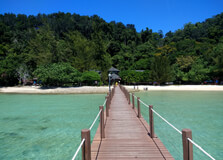
Tunku Abdul Rahman National Park
About Tunku Abdul Rahman National Park Tunku Abdul Rahman National Park is a group of five picturesque islands located off the coast of Kota Kinabalu, Malaysia. Established in 1974, the park is named after Malaysia's first Prime Minister, Tunku Abdul Rahman. The islands are surrounded by crystal-clear waters teeming with vibrant marine life, making it a popular destination for snorkeling, diving, and beach activities. Location and Geographical Overview The Tunku Abdul Rahman National Park is situated just 20 minutes by boat from Kota Kinabalu, making it easily accessible for tourists. The park consists of five islands - Gaya, Sapi, Manukan, Mamutik, and Sulug - each offering unique experiences for visitors. The islands are known for their white sandy beaches, lush tropical forests, and diverse marine ecosystems. Opening and Closing Time The Tunku Abdul Rahman National Park is open daily from 8:30 am to 5:00 pm. Visitors are required to leave the park before the closing time to ensure their safety and security. Entry Fee There is an entry fee to access the Tunku Abdul Rahman National Park, which varies depending on the island you visit. The fee is typically around RM10 for Malaysian adults and RM20 for international visitors. Children may have discounted rates, and fees are subject to change, so it is recommended to check the latest information before visiting. Species-Flora/Fauna Availability The Tunku Abdul Rahman National Park is home to a wide variety of flora and fauna, both on land and in the water. Visitors can spot tropical plants, birds, and butterflies as they explore the islands' hiking trails. Underwater, the park is a haven for marine life, including colorful coral reefs, fish, sea turtles, and even reef sharks. Activities Performed There are numerous activities to enjoy at the Tunku Abdul Rahman National Park, including snorkeling, diving, swimming, sunbathing, hiking, and picnicking. Visitors can rent snorkeling gear or join guided tours to explore the underwater world and discover the beauty of the marine ecosystem surrounding the islands. Jeep Safari Charges Jeep safaris are not available at the Tunku Abdul Rahman National Park. However, visitors can explore the islands on foot or by water taxi to discover hidden beaches, viewpoints, and scenic spots. Age Criterion and Entry Fee Entry fees for the Tunku Abdul Rahman National Park may vary based on age and nationality. Children usually have discounted rates, while senior citizens may receive special pricing or promotions. It is advisable to check the official website or inquire at the park entrance for the most up-to-date information on entry fees. Senior Citizen Facilities The Tunku Abdul Rahman National Park offers facilities that cater to senior citizens, such as benches, shaded areas, and easy access to amenities. Visitors with mobility issues may want to inquire about accessibility options before visiting the park. Best Time to Visit The best time to visit the Tunku Abdul Rahman National Park is during the dry season, which typically falls between March and October. The weather is pleasant, and the water clarity is ideal for snorkeling and diving activities. It is recommended to avoid the monsoon season from November to February, as heavy rains and rough seas may disrupt water-based activities. Nearby Places to Visit There are several attractions near the Tunku Abdul Rahman National Park that visitors can explore, including Kota Kinabalu City, Signal Hill Observatory Platform, Sabah State Museum, and Tanjung Aru Beach. These attractions offer a mix of cultural, historical, and natural experiences that complement a visit to the national park. Vehicle Parking Facility Visitors driving to the Tunku Abdul Rahman National Park can find parking facilities near the ferry terminals in Kota Kinabalu. There are designated parking areas where visitors can safely leave their vehicles while they explore the islands. It is recommended to arrive early to secure a parking spot, especially during peak tourist seasons. Rules and Regulations Visitors to the Tunku Abdul Rahman National Park are expected to follow certain rules and regulations to help preserve the natural environment and ensure a safe and enjoyable experience for everyone. Some common rules include no littering, no feeding of wildlife, no hunting or fishing, and respecting the local flora and fauna. It is important to adhere to these guidelines to protect the fragile ecosystem of the islands. How to Reach and Other Related Information There are several ways to reach the Tunku Abdul Rahman National Park from Kota Kinabalu. Visitors can take a short boat ride from Jesselton Point Ferry Terminal to reach the islands. Ferry services operate regularly throughout the day, making it convenient for tourists to explore the park. Additionally, tour packages and water taxis are available for those who prefer guided trips or private transportation. Overall, the Tunku Abdul Rahman National Park offers a wonderful escape to nature, with its stunning landscapes, diverse marine life, and exciting activities for visitors of all ages. Whether you are looking to relax on the beach, snorkel in clear waters, or hike through lush forests, this national park has something for everyone to enjoy.
Explore More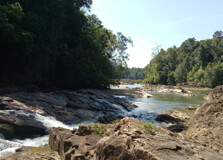
Endau Rompin National Park is a sprawling natural wonder located in the southern region of Malaysia, specifically straddling the states of Johor and Pahang. Spanning an area of over 870 square kilometers, this protected park is one of the largest national parks in Peninsular Malaysia and a significant ecological area that boasts diverse flora and fauna. Known for its lush rainforests, rivers, waterfalls, and wildlife, Endau Rompin is a haven for nature lovers, adventurers, and those seeking a peaceful escape from the urban hustle of Johor Bahru. How to Reach Endau Rompin National Park, Johor Bahru Reaching Endau Rompin National Park from Johor Bahru is quite straightforward, but it requires some planning, as the park is situated about 120 kilometers away from the city. The most common way to get there is by car. You can drive from Johor Bahru via the North-South Expressway, which takes approximately 2 to 3 hours, depending on traffic conditions. From the expressway, you will need to follow the route to Kluang and then head towards the park entrance located in Kampung Peta (Peta Village) in the southern part of the park. Alternatively, you can opt for a public bus from Johor Bahru to Kluang and then take a taxi or other local transportation options to reach the park. However, traveling by car is more convenient, as it allows you to explore the park at your own pace and easily access various trailheads and points of interest within the park. For those coming from outside Malaysia, the nearest international airport is Sultan Ismail International Airport (JHB) in Johor Bahru. From there, you can take a taxi or rent a car to get to the park. Weather at Endau Rompin National Park Endau Rompin National Park experiences a tropical rainforest climate, with hot and humid conditions year-round. The average temperature in the park ranges between 23°C to 32°C, with humidity levels often exceeding 80%. The park is situated at a higher elevation, which provides some relief from the intense heat typically found at lower altitudes. Rain is a frequent occurrence, especially during the monsoon season, which lasts from November to February. During this time, the park sees frequent and heavy rainfall, which can cause certain trails and roads to become muddy or inaccessible. The dry season, from March to October, is generally considered the best time to visit, as there is less rainfall, making outdoor activities and exploration more comfortable. Timing of Endau Rompin National Park The park is open to visitors throughout the year, but it is important to note that certain areas within the park may be closed temporarily during the monsoon season due to safety concerns. The best time to visit the park is during the dry months from March to October when the weather is more favorable for trekking, camping, and exploring the park’s various attractions. The park does not have specific operating hours, as it is an open national park, but it’s advisable to start your activities early in the day. Most visitors come for day trips or multi-day treks, so if you are planning to camp, ensure that you are prepared for the climate and can manage the trails well before nightfall. Why is Endau Rompin National Park Famous? Endau Rompin National Park is famous for its unparalleled natural beauty and its rich biodiversity. As one of the largest national parks in Peninsular Malaysia, it is home to a variety of ecosystems, from tropical rainforests to river systems and rugged mountains. The park is also part of the Endau-Rompin forest complex, which covers both Johor and Pahang, making it one of the most important ecological areas in the region. It is particularly famous for being a habitat for several endangered species, including the Malayan tiger, Sumatran rhinoceros, and the rare tapir. The park is a key site for wildlife conservation, and its importance in preserving Malaysia's natural heritage cannot be overstated. The park is also known for its beautiful waterfalls, such as the Selai and Buaya waterfalls, which attract visitors who are looking for a tranquil environment to relax and enjoy nature. These waterfalls are popular trekking destinations and are an ideal spot for photographers. Entry and Visit Details about Endau Rompin National Park Entry to Endau Rompin National Park requires an entry permit, which can be obtained from the park’s administration office. Visitors must check in at the park's visitor center, located at the Peta Village entrance. It is highly recommended to book your trip in advance, especially if you are planning to camp or take a guided tour. You can contact the park’s tourism office or local tour operators for more information about permits and guided tours. The park offers a variety of activities, including trekking, birdwatching, and camping. If you're planning to trek through the park, ensure that you are physically prepared for the challenging terrain, as the trails can be steep and muddy, especially during the rainy season. Guided tours are available, and they are highly recommended for first-time visitors to ensure safety and to learn more about the flora and fauna. Camping is permitted in designated areas, but you must make prior arrangements for camping permits. Some of the more popular areas for camping include near the Selai Waterfall and Peta River. There are no luxury accommodations within the park, so visitors need to be prepared to rough it a bit with basic facilities such as toilets and camping equipment. History and Architecture of Endau Rompin National Park The history of Endau Rompin National Park dates back to 1993 when it was officially established as a national park. It was created to protect the biodiversity of the region and conserve the unique ecosystems found within the park. The park is named after the two rivers that flow through it – the Endau River and the Rompin River. These rivers are vital to the park’s ecology and play an important role in sustaining the flora and fauna of the area. Endau Rompin National Park does not have traditional architectural structures like those found in urban areas, but it features natural structures such as wooden bridges, hiking trails, and observation platforms that blend seamlessly into the natural surroundings. The park’s buildings are minimal and designed to keep the area as undisturbed as possible while providing essential services to visitors. Things to Do at Endau Rompin National Park Endau Rompin National Park offers a variety of outdoor activities that cater to different types of adventurers and nature lovers. Some of the best things to do at the park include: Trekking: There are several trekking trails ranging from easy walks to more challenging hikes. The trails take you through dense rainforests, past waterfalls, and along riverbanks, offering a chance to experience the park's stunning biodiversity. Camping: For those who enjoy camping, the park offers several designated campsites. Sleeping under the stars, surrounded by the sounds of nature, is a truly immersive experience. Waterfall Visits: The Selai and Buaya Waterfalls are the main attractions for visitors who want to relax, swim, or take photographs of the picturesque landscapes. Wildlife Watching: The park is home to many endangered species, such as the Malayan tiger, rhinoceros, and tapir. If you're lucky, you may spot these rare animals during your visit. Birdwatching: The park is also a birdwatcher’s paradise, with over 200 species of birds, including rare and endemic species that can be observed in their natural habitat. Facts and Tips about Endau Rompin National Park Always check the weather before your trip, as the monsoon season can cause flash floods and trail closures. Bring sufficient supplies, including water, snacks, sunscreen, and a first-aid kit, as the park is remote and there are limited facilities. If you're camping, bring your own camping equipment, including a tent, as there are no rental services within the park. Wear proper hiking shoes, as the terrain can be slippery, especially during the rainy season. Consider hiring a guide if you are unfamiliar with the park, as a guide can enhance your experience by providing information about the wildlife and ecosystems.
Explore More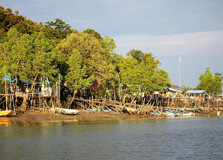
Kuching Wetlands National Park
Kuching Wetlands National Park is a serene haven located just 15 kilometers from Kuching, the capital of Sarawak, Malaysia. Established in 2002, the park spans 6,610 hectares and is predominantly covered by a saline mangrove system. It serves as a crucial habitat for a diverse range of wildlife and offers visitors a unique opportunity to explore one of Borneo's most significant wetland ecosystems. :contentReference[oaicite:0]{index=0}:contentReference[oaicite:1]{index=1} How to Reach Kuching Wetlands National Park To reach the park from Kuching, take a 45-minute drive northeast towards the Santubong Fishing Village. From there, board a boat at the Santubong Boat Club to navigate the Salak and Sibu Laut rivers, which lead into the park. Several tour operators offer packages that include hotel pick-up services for added convenience. :contentReference[oaicite:2]{index=2}:contentReference[oaicite:3]{index=3} Weather Kuching experiences a tropical rainforest climate, characterized by high humidity and temperatures ranging from 24°C to 32°C year-round. The region receives substantial rainfall, especially between November and February. Visitors should anticipate warm and humid conditions, with a likelihood of rain during their visit.:contentReference[oaicite:4]{index=4} Timing The park is open daily, with the best times to visit being during low tide, as crocodiles are more likely to be seen basking on the riverbanks. Wildlife cruises typically operate in the late afternoon, around 4:00 PM, to maximize animal sightings. :contentReference[oaicite:5]{index=5}:contentReference[oaicite:6]{index=6} Why is Kuching Wetlands National Park Famous? The park is renowned for its rich biodiversity, serving as a sanctuary for various endangered species, including the proboscis monkey and the Irrawaddy dolphin. Its intricate network of mangrove waterways offers unique opportunities for wildlife observation, making it a must-visit destination for nature enthusiasts. :contentReference[oaicite:7]{index=7}:contentReference[oaicite:8]{index=8} Entry and Visit Details While there is no formal entrance fee to access the park, engaging in guided wildlife cruises is highly recommended to fully experience its offerings. These cruises provide insights into the park's ecology and increase the chances of wildlife sightings. It's advisable to book tours in advance, especially during peak tourist seasons. :contentReference[oaicite:9]{index=9}:contentReference[oaicite:10]{index=10} History and Architecture Historically, the Kuching Wetlands area has been significant, with evidence of Chinese settlements dating back to the 1st century AD. Archaeological findings include relics from the 9th century, such as early Malay, Hindu, and Buddhist artifacts. The discovery of gold in the 7th century transformed the region into a vital trading and iron mining center, with remnants like enigmatic rock carvings and the ancient Brunei Malay capital of Sarawak from the 15th century still present today. :contentReference[oaicite:11]{index=11}:contentReference[oaicite:12]{index=12} Things to Do Wildlife Cruises: Embark on river cruises to spot proboscis monkeys, Irrawaddy dolphins, estuarine crocodiles, and a variety of bird species. :contentReference[oaicite:13]{index=13} Bird Watching: Observe diverse birdlife, including kingfishers, white-bellied sea eagles, and migratory waders. Photography: Capture the lush landscapes, unique wildlife, and serene river scenes. Sunset Viewing: Enjoy picturesque sunsets over the river, offering a tranquil end to the day. Firefly Watching: Witness the enchanting display of fireflies illuminating the mangrove trees at dusk. :contentReference[oaicite:14]{index=14} Facts and Tips about Kuching Wetlands National Park Wildlife Safety: Crocodiles inhabit the park's waterways. Always maintain a safe distance and follow safety guidelines during boat tours. :contentReference[oaicite:15]{index=15} Best Time to Visit: Low tide periods are optimal for observing crocodiles and other wildlife. :contentReference[oaicite:16]{index=16} Guided Tours: Engage with knowledgeable guides to enhance your understanding of the park's ecology and history. Health Precautions: Carry insect repellent, wear appropriate footwear, and stay hydrated. Preservation Efforts: Respect the park's rules to help preserve its delicate ecosystem for future generations. Conclusion Kuching Wetlands National Park offers a captivating blend of natural beauty and historical significance. Its rich biodiversity, coupled with opportunities for immersive experiences like wildlife cruises and bird watching, makes it a valuable destination for those seeking to connect with nature. By visiting, you contribute to the ongoing efforts to preserve this unique ecosystem, ensuring that future generations can also appreciate its wonders.:contentReference[oaicite:17]{index=17}
Explore More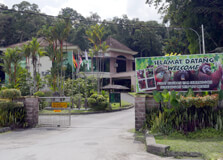
Semenggoh Nature Reserve is a renowned wildlife sanctuary located about 24 kilometers south of Kuching, the capital city of Sarawak, Malaysia. This reserve is famous for its orangutan rehabilitation center, where orphaned and rescued orangutans are rehabilitated before being released back into the wild. The reserve covers an area of approximately 1,000 hectares of tropical rainforest and provides a natural habitat for not only orangutans but also other species of wildlife, including gibbons, hornbills, and various reptiles. How to Reach Semenggoh Nature Reserve, Kuching Semenggoh Nature Reserve is easily accessible from Kuching, and there are several ways to reach the site: By Car: The most convenient way to get to the reserve is by driving. From Kuching city center, it takes about 30-40 minutes to reach Semenggoh Nature Reserve via the Jalan Semenggoh road. By Taxi or Ride-hailing Services: Taxis or ride-hailing services like Grab are also available for visitors who prefer not to drive. The ride will take around 30 minutes from the city center. By Tour Package: Many local tour operators offer guided tours to Semenggoh Nature Reserve, which includes transport, a guided tour of the reserve, and a chance to see the orangutans during feeding times. Weather Kuching has a tropical rainforest climate, which means the weather is generally hot and humid throughout the year. The average temperature ranges from 24°C to 32°C. Rain is common, particularly from November to February, during the monsoon season. The best time to visit Semenggoh Nature Reserve is during the dry season, which typically runs from March to September when rainfall is less frequent, making the trails more accessible and the outdoor activities more enjoyable. Timing Semenggoh Nature Reserve is open every day, and visitors can experience the orangutan feeding sessions during scheduled times: Morning Session: 9:00 AM to 10:00 AM Afternoon Session: 3:00 PM to 4:00 PM During these feeding sessions, visitors have the opportunity to see the orangutans up close as they come down from the trees to be fed by the reserve’s staff. It is recommended to arrive early for the feeding sessions as the number of visitors may be limited. Why is Semenggoh Nature Reserve Famous? Semenggoh Nature Reserve is most famous for being home to the Semenggoh Wildlife Rehabilitation Centre, which rehabilitates orphaned and displaced orangutans. The reserve’s primary focus is on orangutan conservation, and it plays a vital role in the protection of Bornean orangutans, which are an endangered species. Visitors can witness the incredible success of the rehabilitation program and watch the orangutans during the feeding sessions. The reserve is also known for its lush rainforest, rich biodiversity, and its commitment to environmental education and wildlife conservation. Entry and Visit Details about Semenggoh Nature Reserve The entry fee to Semenggoh Nature Reserve is quite affordable. The general entry fee for adults is around RM 10, and RM 5 for children and locals. Fees may vary depending on the type of visit and any special events being held. Visitors can take guided tours to get a deeper understanding of the reserve’s efforts in wildlife conservation. The tour typically includes information about the orangutans, the reserve’s history, and the flora and fauna of the region. There are also educational displays and exhibits at the reserve’s visitor center. History and Architecture of Semenggoh Nature Reserve Semenggoh Nature Reserve was established in 1975 by the Sarawak Forestry Department with the aim of protecting the endangered species of Borneo, particularly the orangutans. The reserve has since become a crucial site for research, conservation, and wildlife education. The Semenggoh Wildlife Rehabilitation Centre within the reserve was founded in 1978 to care for orphaned and injured orangutans, with the goal of releasing them back into the wild once they are rehabilitated. The architecture of the reserve itself is built to blend with the natural surroundings, with simple wooden structures and walkways that allow visitors to explore the forest without disturbing the wildlife. The reserve is surrounded by lush tropical rainforest, and visitors can experience the natural beauty of Borneo while learning about conservation efforts. Things to Do at Semenggoh Nature Reserve Watch Orangutans: The primary attraction at Semenggoh Nature Reserve is the opportunity to see the orangutans in their natural habitat. The morning and afternoon feeding sessions offer the best chance to spot these incredible animals up close. Explore the Trails: There are several well-maintained walking trails that lead visitors through the rainforest, offering a chance to enjoy the park’s flora and fauna. Keep an eye out for other wildlife such as gibbons, monkeys, and a variety of bird species. Bird Watching: Semenggoh is a great place for bird watching, with numerous species of birds residing in the reserve. The forest is home to various hornbills, kingfishers, and other tropical birds. Photography: The reserve offers numerous opportunities for photography, from capturing orangutans during feeding times to photographing the beautiful rainforest landscapes and wildlife. Educational Tours: Take a guided tour to learn about the conservation efforts at the reserve, the rehabilitation process for orangutans, and the significance of preserving Borneo’s wildlife. Facts and Tips about Semenggoh Nature Reserve Bring Binoculars: For the best chance of spotting wildlife in the trees, including the orangutans, it’s helpful to bring binoculars. Wear Comfortable Shoes: The trails can be a bit uneven, so wearing comfortable walking shoes is a must if you plan to explore the reserve’s walking paths. Respect the Animals: While the orangutans are semi-wild, they are still free to roam and come and go as they please. Visitors should maintain a safe distance and avoid disturbing the animals. Check Feeding Times: Be sure to check the feeding schedule before your visit, as this is the best time to see the orangutans up close. Stay Hydrated: The rainforest can be hot and humid, so make sure to carry water and stay hydrated while exploring. Plan for a Half-Day Visit: A visit to Semenggoh Nature Reserve can take a few hours, especially if you want to enjoy the feeding sessions and explore the trails, so plan for a half-day trip. Conclusion Semenggoh Nature Reserve offers a unique and educational experience for nature lovers, wildlife enthusiasts, and anyone interested in conservation efforts. With its focus on the rehabilitation of orangutans and its rich biodiversity, the reserve provides visitors with an opportunity to connect with nature in a meaningful way. Whether you’re watching the orangutans during feeding time, exploring the rainforest trails, or learning about the conservation initiatives, Semenggoh Nature Reserve is a must-visit destination in Kuching, Sarawak.
Explore More